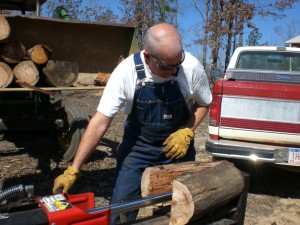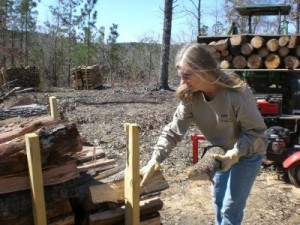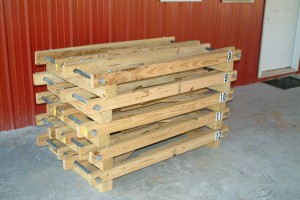I posted a few days ago about how we plan to stay warm during the relatively mild central Alabama winter. This post is more specifically focused on our cutting, splitting, and storage of firewood.
Here are the tools we’re using:
- We own a Stihl 029 chain saw with an 18 inch bar
- We own a 27-ton Troy-Bilt wood splitter with a 5.5 hp Honda engine. It was originally sold at Lowe’s; I bought it on E-bay from a fellow in Auburn.
- We use Tractor for toting. You’d just be amazed what you can do with a tractor with a front-end loader. More about that in a later post.
I bought the chain saw several years ago, long before we had any idea that we would become subsistence farmers. It still runs well, although I am told the Ethanol fuel blend they sell now will eventually cause it to clog up. I fiddled around for years using those “safety” or “low kickback” chains, because the manufacturer said that’s what I should do. I tried to sharpen them but it never seemed to help, so I assumed I was an idiot who didn’t know how to sharpen a chain saw.
Then one day last fall, on my brother Dave Gray’s advice, I bought one of those DANGER!!!! HIGH RISK OF KICKBACK!!! YOU WILL DIE IF YOU USE THIS CHAIN!!! chains. It’s the ticket. I own about three of them but have been using the first one pretty steadily for several months; the other two are still new in the package. I just keep it sharpened with a few passes of the files (round file for the cutting surface, flat file to lower the guide link) after every 3-4 tanks of gas, and it’s doing fine. I am careful about kickback, but I’ve always been careful about kickback, so it hasn’t changed my cutting technique.
The chain saw uses fuel quickly and has a small tank, so we don’t take the chain saw any distance without also taking its gas can. It uses chain oil much more slowly, so I can usually begin the day with a full oil tank and not have to refill it until it comes back to the barn. I check it each time I refill the gas tank to be sure (you NEVER want to run out of chain and bar oil while running), but I can usually refill the gas tank 4-5 times before needing to refill the oil tank.
I always wear ear protection and eye protection when using the chain saw. No exceptions, not even for “one quick cut.” It’s too dangerous, bad things happen too fast, and my hearing is already going.
 We use Tractor’s bucket to bring the cut logs to the splitter. Our splitter will hitch to the truck and roll like a small john boat trailer, so I guess we could try to take the splitter to where we cut the wood. So far, though, it has made more sense to leave the splitter very close to the barn and to bring the logs to it. Amanda is about to fill up the bucket. It takes us about three buckets to fill up a pallet, and a pallet holds a 1/4 cord. So what you see here is about 1/12 of a cord. As I said in an earlier post, a real cord is a LOT of wood.
We use Tractor’s bucket to bring the cut logs to the splitter. Our splitter will hitch to the truck and roll like a small john boat trailer, so I guess we could try to take the splitter to where we cut the wood. So far, though, it has made more sense to leave the splitter very close to the barn and to bring the logs to it. Amanda is about to fill up the bucket. It takes us about three buckets to fill up a pallet, and a pallet holds a 1/4 cord. So what you see here is about 1/12 of a cord. As I said in an earlier post, a real cord is a LOT of wood.
If you go from pallet #1 to pallet #7 (the one we’re working on now), you’ll see an evolution in the length of the wood. I started out cutting the pieces sort of any old length, erring on the short side rather than the long side. So the first couple of pallets are stacked every which way, some short, some long, etc. Now I’m being much more careful to cut all the lengths closer to the same length, around 17″, using the length of the chain saw’s guide bar as a quick ruler. The last couple of pallets look neater, and because of the uniform length of the sticks, the wood is more stable on the pallet. I can’t say for sure yet, but it’s possible that #12 will be neater than #7 as I learn better how to keep the sticks at a uniform length.

Yes, my bald dome got sunburned!
The guy who sold me the splitter had apparently run it without enough hydraulic fluid (didn’t discover that until I had already bought it). I say apparently because I don’t know whether he ran it at all; I just know that when I checked the hydraulic fluid the level was very low. I know that’s a bad thing, but I don’t yet know HOW bad. So far it’s running fine and has not stalled in dealing with anything we’ve thrown at it. My brother and his friend Larry think I’m stupid for doing this, but I like to run it in horizontal mode (as opposed to sitting in front of it and running it in vertical mode). I park Tractor just a few feet from the splitter with the bottom of the bucket at at belly button height. Then I stand between Tractor and the splitter, just grabbing a piece and putting it on the splitter.
 As soon as I have a piece split small enough, I hand it to Amanda and she puts it on the pallet. The pallet has two racks, so she always stacks the far rack first and then the close rack. This helps her avoid having to reach across one rack to stack the other.
As soon as I have a piece split small enough, I hand it to Amanda and she puts it on the pallet. The pallet has two racks, so she always stacks the far rack first and then the close rack. This helps her avoid having to reach across one rack to stack the other.
Amanda and I have a running dialog about how thin the pieces should be. I tend to want to split them down to thinner sticks, and she thinks we can use them thicker. Because neither of us has any experience using this stove (or for that matter any wood stove), we have no idea which one of us is on the right track and won’t know until we get through a season of burning.
If the wood we’re cutting is green, the pallet will be REALLY heavy when we’ve just filled it. But after splitting and stacking, it will lose (I am told) about a third of its weight in moisture within a couple of months.

Pallets 8-12 stacked
Each pallet consists of (from the ground up) 2 34″ lengths of treated 4 x 4, and one 65″ diagonal 1 x 4 brace attached to the 4 x 4s with deck screws, 4 60″ lengths of treated 2 x 4 for horizontals, 2 3/4 inch diameter steel “nipples” with an end cap on each end, and 4 42″ lengths of treated 2 x 4 for the uprights. Each end of the horizontals and one end of each vertical have a 1″ hole bored in them to fit around the 3/4″ nipple. We bolted the horizontals to the 4 x 4s using galvanized 5″ x 5/16″ lag screws and one washer.
We added the diagonal brace as an afterthought when we realized that the pallets weren’t staying square! Unfortunately, we didn’t figure this out until we had filled six pallets. So pallets 1-6 don’t yet have a diagonal brace. Now that they’re full of wood, we’ll need to wait until we empty them to install their diagonal.
The steel nipple threads through the attached horizontals and the free-swinging verticals, so the uprights pivot at one end. We slotted the uprights so they fit flush; if we hadn’t done this the uprights would hit the diagonal brace when we fold them down and stick up, which would keep us from being able to stack the pallets. We’ve numbered each pallet so we can remember which one to burn next. We’ve filled pallets 1-6, we’re working on #7 now, and pallets 8-12 are ready to use.
When I bought the nipples, they didn’t have them galvanized, but the guy at the plumbing supply place sold me some galvanizing spray, which I carefully applied to all the surfaces of the nipples. Can’t tell that it did a bit of good. The nipples that are out in the weather are rusting noticeably. I don’t think it’s a big problem, so I’m not doing anything to address it.
Each pallet holds about 1/4 cord, so the six pallets we’ve already filled account for 1 1/2 cords or so. If we ever have all 12 pallets filled, we’ll have three cords.
When we cleared land for the barn site and the house site, we had to push down several good sized oak and hickory trees. Dave Gray was kind enough as he pushed them down to hold each trunk with his excavator while I bucked the trunk, cut off the stump, and cut off the top. So we have a good-sized stack of “big sticks” still waiting to be cut, split, and stacked. This coupled with normal deadfall and the logging debris scattered around in the forest has meant that we haven’t yet had to cut down any healthy trees for firewood. Right now I’d be surprised if we ever had to do that, because we’re seeing new deadfall all the time.
As I said in an earlier post, the manufacturer of our stove says it will burn pine just fine, so we’re trying to see if that’s true. Pallets #4 and 5 (and no others) have a generous sprinkling of pine on them. Dave Gray expects it to be entirely too smoky and messy; he thinks that once we try it in the stove, we’ll quickly decide to pull the rest of it off the pallets and reserve it for burning only in outside fires. Of course most of his experience is with fireplaces, which we know burn far less efficiently than a new technology wood burning stove. Time will tell.